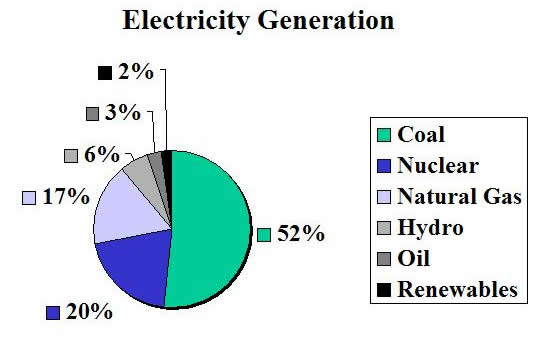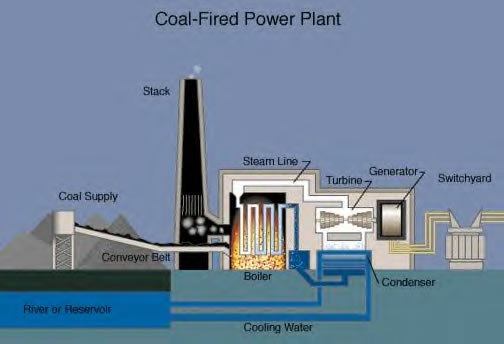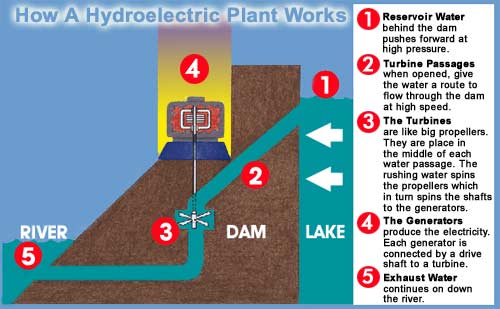The Energy Story
| Energy Sources | |
| Power Plants | |
| Power Plant Game |
The Energy Problem
The Energy Solution
Energy Generation Much of the energy we use is produced in large power plants. Those plants extract the energy from some source, such as coal, and change that energy into the energy of choice, electricity. Then that electrical energy can be transported to where it is needed. Contrary to what you might expect, the source energy goes though a number of changes before being turned into electrical energy, leading to a chain of energy changes. Power Plants In 2001, total US generation of electricity was 3,777 billion kilowatt-hours. The % of electricity produced from each source of energy is shown below in a pie chart.
Coal Fire Power Plant Let's look at a typical coal fired power plant.
The coal is burned in a boiler which produces steam. The steam is run through a turbine which turns a generator which produces electricity. A turbine is like a fan in reverse, with many vanes or blades, where the steam is used to make the turbine turn or rotate rapidly. A generator is a huge magnet that is turned by the turbine. As the magnet turns inside a coil of wire, electricity is produced. So, the energy chain for this power plant would look like this:
The huge magnet assists in changing the mechanical energy into electrical energy, but the mechanical energy does not actually turn into magnetic energy. This is complicated since electrical and magnetic energy are so intimately related to one another. Most energy power plants, whether the source of energy is the burning of coal, oil, natural gas, or the fissioning of uranium, follow the same energy chain shown above. Hydroelectric Power Plants
Here the energy chain is different, since there is no fuel to be burned, there is no need for the steam boiler. The gravitational energy of the water is used to turn the turbine directly.
Nuclear (Fission) Power Plants Uranium is usually formed into pellets which are arranged into long rods, and the rods are collected together into bundles. The bundles are then submerged in water inside a pressure vessel or reactor. The fission reaction is a chain reaction, each uranium atom that fissions or breaks apart gives off two neutrons that will cause two more atoms to fission. To prevent this, control rods made of a material that absorbs neutrons are inserted into the bundle using a mechanism that can raise or lower the control rods. The uranium bundle acts as an extremely high-energy source of heat. It heats the water and turns it to steam. The steam drives a steam turbine, which spins a generator to produce electricity. The animation below illustratees this process.
a)
containment structure b) control rods c) reactor d) steam generator
e) steam line f) pump The energy chain for a nuclear power plant is nearly identical to the coal power plant. The only difference is the initial or source of energy, which is nuclear instead of chemical.
For more information
on power plants, check out the sites below:
| |||||||||||||||||||||||||
|
|



